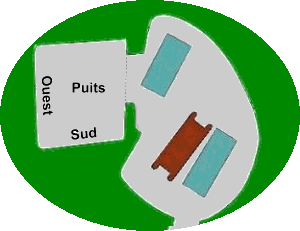Ahiram, Roi de Byblos
Le plus ancien et le plus célèbre sarcophage phénicien est celui d'Ahiram, roi de Goubal (Byblos). Il a été découvert lors des fouilles entamées par des archéologues français suite à un glissement de terrain. Trouvé dans la tombe V, ce sarcophage est actuellement conservé dans le Musée National de Beyrouth. Il représente une des pièces les plus importantes, sinon la pièce maîtresse de la collection du musée. Il date du XIII° siècle av., a servi pour l’enterrement d’un égyptien et réutilisé par Ithobaal pour l'inhumation de son père Ahiram.

Musée National
Ce sarcophage est surtout célèbre grâce à l'inscription en caractères alphabétiques phéniciens qui commence sur le bord supérieur du petit côté de la cuve et se termine sur le couvercle. Écrite de droite à gauche, cette inscription représente le plus ancien texte qui nous soit parvenu en écriture phénicienne linéaire. Des vingt-deux lettres de l'alphabet phénicien, dix neuf y apparaissent. Elle indique que ce sarcophage était réalisé par Ittobaal, fils d’Ahiram, roi de Goubal, pour son père, comme demeure pour l’éternité.
"Si un roi, un gouverneur ou un chef d’armée se présente devant Goubal (Byblos) et ouvre le sarcophage, que son sceptre se brise, que le trône de son royaume tombe, que la paix s'échappe de Goubal et que sa mémoire s’effacera pour l’éternité."
D'après l'archéologue Hélène Sader(1), il est généralement admis que le sarcophage date bien du XIII°siècle av. J.C. et qu'il est plus ancien que l'inscription qu'il porte (l'alphabet en 19 lettres). Les examens effectués sur ce monument ont révélés des traces d'une inscription pseudo-hiéroglyphique plus ancienne que l'inscription phénicienne. D'autres part, des objets portant le cartouche de Ramsès II (XIII°siècle), avaient été trouvés dans la chambre funéraire à côté du sarcophage. L'inscription phénicienne atteste quant à elle la réutilisation du sarcophage par Ahiram ; sa graphie est plus souvent datée du X°siècle.
Les spécialistes restent partagés face à cette divergence. Certains adoptent la même date pour l'objet et l'inscription, soit celle du sarcophage (le XIII°siècle), tandis que d'autres optent que le texte, vue la forme de son écriture, date du dixième siècle, la période du gouvernance d'Ahiam à Byblos, et que le sarcophage a été probablement réutilisé. Les études scientifiques n’ont toujours pas réussi à bien dater l’ensemble, la question reste toujours posée : A quelle date était gravée la plus vielle écriture en lettres phéniciennes ?


De forme parallélépipédique, ce sarcophage, gravé dans la roche calcaire, repose sur quatre lions accroupis, les figures, sur les deux côtés, représentent des processions. D'une part, on voit le souverain (ou un dieu) sur un trône, encadré de sphinx ailés, face à lui une table dressée vers laquelle s'avancent les dévots et porteurs d'offrandes. Sur le deuxième côté on voit également des dévots en cortège funéraire. Sur les petits côtés, on retrouve des gravures représentant des femmes se frappant et s'arrachant les cheveux en signe de deuil. Sur le couvercle, on distingue deux personnages tenant chacune une fleur de lotus, face à face et séparés par deux lions à l’image de ceux de la base du sarcophage. On peut supposer que ces deux personnages représentent le roi Ahiram portant la fleur du lotus fanée, symbolisant la mort, et son fils Ittobaal, portant le lotus épanouissant, représentant la vie. Les têtes des lions qui dépassent de chaque côté du couvercle servaient ainsi pour le manœuvrer. Des traces de peinture rouge se trouve encore sur ce couvercle qui signifient que le sarcophage était peint.
Durant le conflit qui a ravagé le pays des cèdres à partir de 1975, n'ayant pu déplacer ce sarcophage à cause de ses dimensions, les responsables du musée, sous la direction de l’émir Maurice Chéhab, avaient décidé de le laisser sur place tout en l'enveloppant et le protégeant dans du béton armé afin de le préserver contre le pillage et les dégâts liés aux combats. En 1991, les travaux de restauration pour la réouverture du musée ont été entamés. Le sarcophage fut décoffré, remis en état et exposé.

Décoffrage sarcophage d'Ahiram
Ce sarcophage fut prêté à l’Institut du Monde Arabe à Paris pour une exposition, « Liban, l’autre rive », qui a eu lieu dans les locaux de l’IMA, du 27 octobre 1998 au 2 mai 1989. Depuis, il a repris sa place au milieu de la collection du Musée National de Beyrouth.
| (1) |
Hélène SADER, article tiré du livre Liban, l'autre rive, IMA, Flammarion, 1998, p.126. |
Retour texte |





